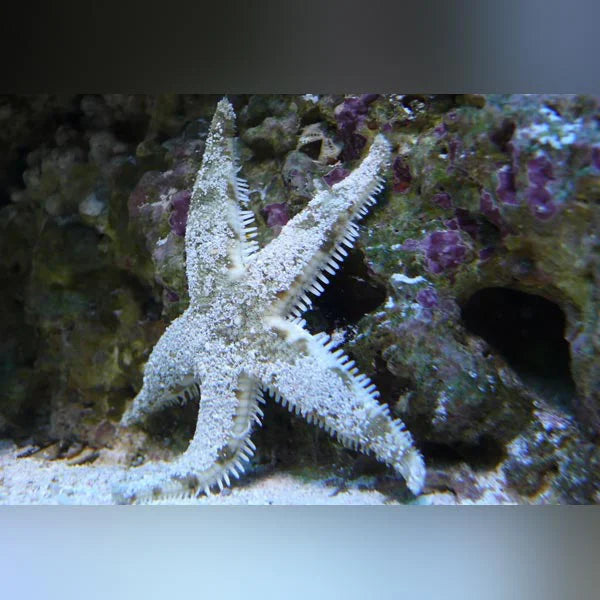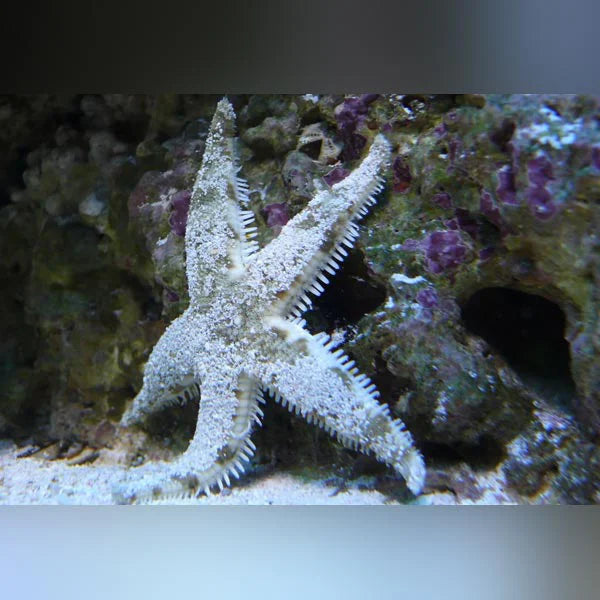SLA
Saltwater fishSand Sifting Starfish
Sand Sifting Starfish
Couldn't load pickup availability
Sand Sifting Starfish: The Voracious Burrower
The Sand Sifting Starfish (Astropecten polyacanthus), also commonly known as the Comb Sea Star, is a popular marine invertebrate valued for its diligent sand-sifting behavior. This species is an active hunter, spending most of its time buried just beneath the sand surface, where it helps aerate the substrate and consumes detritus.
This starfish has a classic five-arm shape, with a coloration that typically ranges from beige to brown or tan, allowing it to blend seamlessly into the sand. Unlike other sea stars, its tube feet are pointed rather than equipped with suckers, which is an adaptation for digging. It can reach a maximum size of 6 to 8 inches (15-20 cm) in diameter.
While a highly effective member of a cleanup crew, the Sand Sifting Starfish is a voracious predator of desirable microfauna, and its specific care requirements often lead to its demise in all but the largest, most mature aquariums. It is a beautiful but challenging addition for the intermediate to advanced hobbyist.
Diet & Compatibility:
- Profile: The Sand Sifting Starfish is an active Carnivore / Omnivore. While it does consume detritus and uneaten food, its primary diet consists of living organisms found in the sand bed, such as worms, small snails, bivalves, and other micro-crustaceans.
- Aquarium Environment: This starfish should only be kept in a large, mature aquarium (75+ gallons) with a deep, established sand bed (3+ inches). It is a highly efficient hunter and will quickly deplete the food source in smaller or newer systems, leading to starvation.
- Supplemental Feeding: Supplemental feeding is almost always required to prevent starvation. You can target-feed the starfish by placing meaty foods such as chopped seafood, mysis shrimp, or sinking pellets onto the sand near it. A starving starfish will begin to lose weight, appear shriveled, and may climb the glass.
- Reef Compatibility: It is Reef Safe With Caution. While it will not harm corals, it will systematically hunt and consume beneficial sand-dwelling invertebrates. It is sensitive to sudden changes in water parameters, including salinity, pH, and dissolved oxygen, and cannot tolerate copper-based medications.
- Handling Caution: Use a very long and slow drip acclimation (1-2 hours minimum) for all new specimens. Never expose the starfish to open air during handling, as trapped air bubbles can be fatal. This species is also known to contain the potent neurotoxin tetrodotoxin (TTX), the same as found in pufferfish, making ingestion or physical contact with spines a potential risk.
- Tank Mates: Only house with peaceful fish. Avoid known starfish predators such as Harlequin Shrimp, Pufferfish, and Triggerfish.
Quick Facts
- Scientific Name: Astropecten polyacanthus
- Primary Common Name: Sand Sifting Starfish
- Other Common Names: Comb Sea Star, Sand Star
- Origin: Indo-Pacific (Widespread)
- Max Size: 6-8 inches (15-20 cm)
- Temperament: Peaceful (but predatory toward small fauna)
- Diet: Carnivore / Omnivore (Hunts microfauna in the sand)
- Minimum Tank Size: 75+ Gallons (with deep sand)
- Reef Compatibility: With Caution (Will eat beneficial sand fauna)


